The introductions begin: 1836–1880
Pest animal and weed control has been a necessity since South Australia was colonised by Europeans in 1836. While initially the colonists’ principal concern was to establish themselves and their communities – supplies of food and water were vital – the activities of settlement required the authorities to take action to prevent specific threats posed by diseases of animals and plants, unwanted animals and plants or the actions of people.
The Europeans’ arrival was accompanied by habitat disturbance, vertebrate animals that became pests, plant introductions and weed dispersal through settlement, grazing, cropping which removed native vegetation, soil cultivation and the planting of crops and pastures, all which modified the environment.
The material covered in this article pre-dates the introduction of metric measurements under the Metric Conversion Act 1970. Distance and weight measurements have been given in Imperial form (generally followed by metric equivalents). Also, it is an unnecessary and misleading exercise to adjust the currency from the pre-decimal pound (£), shilling (s) and pence (d). Today the value of £1 would be vastly different to the decimal equivalent of $2 when the currency was converted on 14 February 1966.
Introduction of pest animals
Since European settlement South Australia's native animals have had to compete with a range of introduced animals for habitat, food and shelter. Some have also had to face new predators. These introduced, feral animals, no longer subject to their traditional natural predators or fatal diseases, multiply rapidly if conditions are favourable and some have high reproductive rates. Therefore, pest animals have been difficult to eradicate or control because they can outbreed virtually anything used against them and have readily adapted to their new environment.
Those pest animals which had some significance for primary producers, other landholders and the Government during the period 1836 to 1880 are described below.
Goats
Goats
Domestic goats arrived in Sydney with the First Fleet in 1788 and the first settlers to South Australia brought domestic goats with them in 1836 and cashmere goats in 1837 [1], and these domestic populations thrived. Attempts were made from 1860 to 1900 to establish a goat fibre industry, using angora and cashmere goats imported from Asia. Explorers took goats into the Flinders Ranges in the 1840s and these domesticated animals wereused as a source of milk and meat. Goats were abandoned, deliberately released or escaped to establish feral herds in a wide range of habitats across the State. Overgrazing by goats has had detrimental impacts on both arable land and natural environments.
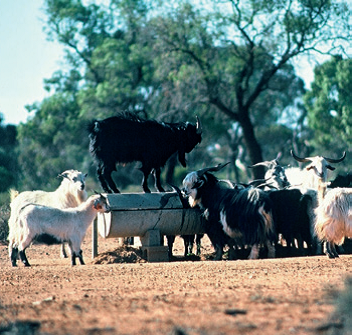
Feral goats. Image: PIRSA
[1] Hodder 1893. Parkes, J., Henzell, R. & Pickles, G. Managing vertebrate pests: feral goats (AGPS, Canberra, 1996). Aitken in Corbett 1980. Evans 1980.
Foxes
Foxes
The European red fox was deliberately introduced to Australia in 1855 for recreational hunting and fox populations became established in the wild in Victoria in the early 1870s [2]. By the end of that decade, foxes began to cross into South Australia so that in the 1880s foxes were common along the Coorong and further southeast where they were almost as numerous as dingoes. Reports suggest that a single male fox resided in the Botanical Gardens in Adelaide in 1869 [3]. Foxes are highly adaptable animals and they were able to establish themselves in urban and urban fringe areas as well as throughout agricultural areas.
The fox is a major predator of lambs and rabbits, but not so much so that it decimatedaffected populations of the latter. It is a significant contributor to native animal decline and continues to undermine recovery efforts for threatened species. Kangaroo Island remains free of foxes.
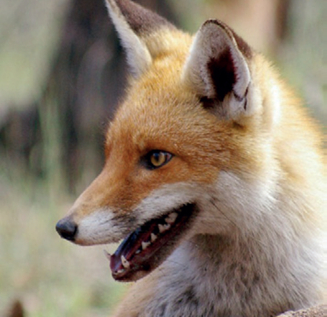
European red fox. Image: PIRSA
[2] http://www.environment.gov.au/biodiversity/invasive-species/publications/factsheet-european-red-fox-vulpes-vulpes, accessed 19/11/19.
[3] N. Newland, ‘Vermin control in South Australia: An historical account of legislative efforts to control animals defined as ‘vermin’’.
Rabbits
Rabbits
Rabbits are often considered the main pest species, animal or plant that Australia has had to confront. Governor Arthur Phillip came to Australia with five rabbits on the First Fleet in 1788 and 16 rabbits arrived on the vessel Governor Gawler in South Australia in 1840 [4]. Other people brought them subsequently, notably Thomas Austin who imported 24 wild European rabbits to his property Barwon Park near Geelong, Victoria in 1859. His rabbits thrived and precipitated a spread throughout the continent. This most serious of the pest problems in South Australia arrived in August 1836 on the vessel John Pirie. In 1837 the Everard Family were recorded as having 14 rabbits and that same year rabbits were released on the mainland at Encounter Bay.
These populations were successfully suppressed by dingoes and wild dogs so rabbits were released on Granite (formerly Rabbit) Island, Wright and West Islands. In comparison, these island populations flourished. Rabbits were being advertised for sale in 1841 and in 1842 rabbits were being continuously released into the sand hills at Henley Beach but they were exterminated by dingoes and wild dogs, which were too numerous [5].
Also, the report of a rabbit warren on John Daw’s farm at St Mary’s (where Daws and South Roads intersect) was dated to 1840 [6]. By 1843 rabbits were listed produce for sale at the Adelaide Market [7].
A few hares were acclimatised at the Reedbeds in 1862 (the Reedbeds was low swampy reed country and a wetland system stretching from the Patawalonga at Glenelg to the Port River Estuary) where some of the populace hoped they would survive to provide sport for parties of shooters [8]. By 1864 domestic rabbits were running wild in Adelaide’s city and suburban gardens. However, that same year the South Australian Parliament included the rabbit with other animals in the Games Act, protecting any rabbit from being destroyed or taken from the wild for four months of the year, August to December.
In 1871 the Adelaide Observer reported that market gardeners breeding rabbits on the slopes of the Adelaide Hills were letting them run wild on their properties [9].
Sometime just prior to 1870 rabbits were released on Anlaby Station near Kapunda, South Australia, on one or more occasions. The rabbits spread widely from Kapunda which appears to have been a second centre of the spread and almost as important a source as Barwon Park. In fact the rabbits were so prolific that in August 1870 the Governor paid a visit to Anlaby to participate in a day's shooting [10]. The rabbits had established so quickly that in 1873, nine years after the Parliament passed a law to protect them, and only three years after their release at Kapunda, residents of several districts petitioned for legislation to destroy them. By 1875 rabbits were established from the hilly country to the north-east of Adelaide to the southern end of the Flinders Ranges.
Rabbits had now become such a problem that Parliament passed the Rabbit Destruction Act 1875, under which district councils could apply to be declared be rabbit districts, thus acquiring the power to compel landowners to destroy rabbits on their properties. Landowners outside district councils could petition for rabbit districts to be formed under the Commissioner of Crown Lands. If the owner failed to comply with a notice to control rabbits, then the council or the Commissioner could enter the land and arrange for the control of the rabbits, the cost of destroying them being recoverable from the owner. The Commissioner of Crown Lands appointed Government Rabbit Inspectors to check on rabbit numbers.
In all, 55 rabbit districts were proclaimed under the Act both within and outside of council districts. For each district, either the district council or, outside of council districts, the Commissioner of Crown Lands was responsible for ensuring the destruction of rabbits within the district. District councils or the Commissioner of Crown Lands could levy rates on landholders for the purposes of the Act which included offering rewards or bonuses for the destruction of rabbits.
The ‘rabbit nuisance’ was attacked immediately: 139,680 scalps were paid for and £100 was spent in digging out burrows on Anlaby Station between July 1875 and December 1876 [11]. An amendment to strengthen and expand the Act was made in 1878 by providing the Commissioner with the responsibility to control rabbits on all Crown land and leased pastoral properties and making it an offence for a person to release a rabbit into the wild.
The Rabbit Meat Preserving Companywas established at Kapunda in 1877 to cope with the increase in rabbits. Rabbit meat was tinned and shipped to England and about 6,000 rabbits a day were processed. By 1878 the Company had depleted the neighbourhood, and trappers went 50 kilometres for their main supplies. But the Company did not take young rabbits and they were often released [12].
But the problem did not abate, so the Act was replaced by the more stringent Rabbit Suppression Act 1879. Now the Commissioner of Crown Lands was empowered to put parties of men to work destroying rabbits and their warrens on the properties of uncooperative landowners and to recover the cost of the work. Crown land was considered a haven for rabbits and so the Commissioner was required to destroy all rabbits and fill up their burrows on Crown lands, with the cost borne by the general revenue of the colony. Very soon even larger sums were being spent on rabbit control work, the annual cost quickly accruing to approximately £10,000. Councils and other bodies were also required to destroy rabbits on land they managed/owned. Releasing a rabbit into the wild remained an offence but the maximum penalty was increased from £10 to £100, an incredible amount for the time.
Parties of six men (or, where practicable, four men and two boys) were formed by the Government under the command of a foreman to destroy the rabbits. These parties worked on Crown and leasehold land while at the same time inspectors in charge were instructed to induce local farmers to institute simultaneous action for the destruction of the rabbits and burrows existing upon their land [13]. To give an example of the extent of the Government’s commitment to destroying rabbits, by September 1879 there were 22 parties working in the Barossa Valley, around Eudunda, in the Mid North around Jamestown-Mannanarie area, near Burra, and between Mannum and Milang [14].
The preferred eradication method was to fumigate the warrens with carbon bisulphide; other methods were trapping, dogging, netting, shooting and poisoning. The colonists had undoubtedly played a part in the rapid establishment of the rabbit and had no conception of the consequences. By the time they realised what a devastating pest had been introduced, the damage was done. The introduction of predators such as cats in an attempt to control the rabbits took no account of their possible effect on our vulnerable marsupial wildlife and on small birds which were easy prey [15]. A further proposal in 1878 was to have native predators of rabbits, such as wild dogs, native cats, eagles, hawks, and crows, protected so they could destroy the rabbits [16].
A report at the time stated that if even two rabbits only were left it was estimated that a single pair in the average life time of the rabbit (four years) would produce a progeny numbering about 4,000,000 [17].
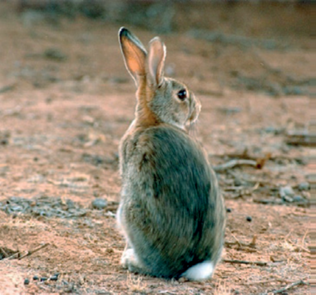
European rabbit. Image: PIRSA
[4] The Manning Index of South Australian History: Rabbits, SLSA.
[5] Peacock, D and Abbott, I: The role of quoll (Dasyurus) predation in the outcome of pre-1900 introductions of rabbits (Oryctolagus cuniculus) to the mainland and islands of Australia, Australian Journal of Zoology, 2013, 61, 206–280.
[6] N. Newland, citing Papers relative to South Australia. Presented to both Houses of Parliament (London, HMSO, 1843), provides the year of 1840.
[7] Adelaide Observer (SA Saturday 30 September 1843 p 4) and South Australian Register (Adelaide Wednesday 13 December 1843 p 2)
[8] ‘The Manning Index of South Australian History’: South Australia – Flora and Fauna: Rabbits’
[9] Adelaide Observer (SA: 1843–1904), Saturday 5 August 1871, page 9
[10] South Australian Register (Adelaide, SA: 1839 –1900), Saturday 13 August 1870, page 8
[11] Manning
[12] Hodder, p. 276.
[13] Manning
[14] Newland citing SAPP137:1879.
[15] Newland – p. 2
[16] South Australian Register (Adelaide, SA: 1839–1900), Wednesday 28 August 1878, page 3
[17] South Australian Register (Adelaide, SA: 1839–1900), Saturday 10 February 1877, page 6
Dingoes
Dingoes
The dingo is regionally related to the wild dog of Thailand and arrived in Australia some 4,000 years ago with Asian seafarers, who used it both as food for the voyage and as a guard animal. Dingoes are found only on mainland Australia and have been incriminated in the extinction from the mainland of the Tasmanian tiger and the Tasmanian devil. Uncontrolled and unchecked, they make sheep grazing unviable and can threaten other stock, humans and native fauna. They do not make suitable pets. The name dingo is a corruption of the Aboriginal word Tingo.
The pest potential of the dingo was recognised in the earliest days of settlement. In September 1837, the Governor offered a reward for the destruction of wild dogs/dingoes. The reward was generous at 7 shillings for every female, 5 shillings for every male and 2 shillings for every pup [18]. Ten months a plan for dingo destruction was published and in 1843 dingoes were still causing stock losses at Glen Osmond [19]. Attacks on stock at Mount Barker in 1845 led to requests for landholders being invited to the area to hunt the wild dogs responsible as a neighbourly service [20]. Hunting wild dogs/dingoes became a sport from 1845 and hunts were still occurring in the Reedbeds in 1869 [21].
But it was the damage caused by tamed or vagrant domestic dogs to animals, stock and people that led to the first Dogs Act1852, the purpose of which was “to abate the Nuisance and Damage to Property occasioned by the Great Number of Dogs which are loose in the Province of South Australia”. Registering dogs in certain areas was mandated: anyone could destroy an unregistered dog or a dingo, for which a bounty was payable. Any policeman who did not destroy an unregistered dog or dingo, or destroyed one without due reason, was liable to be fined. Exempted from the Act were muzzled sheep dogs.
A new Dog Act was passed in 1860 to prevent the damage being done by wild dogs and dingoes in the colony by creating broader registration districts, made up of district councils and local government corporations. In 1867 the Act was amended to provide for harsher measures to be taken so that now, for the first time, an animal’s destruction could be enforced. The Act also formally continued the bounty for the destruction of a wild dog/dingoprovided that a person could be paid the sum of 2 shillings and 6 pence for destroying an unregistered domestic dog or 7 shillings and 6 pence for a dingoIn both these Acts,the hunting dogs of Aborigines were excluded from the requirements of the Act.
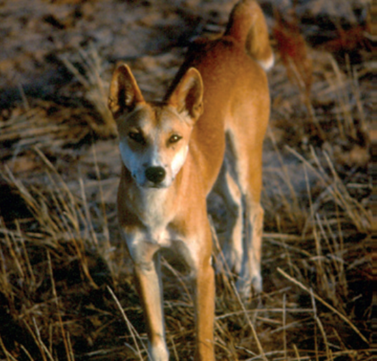
Dingo. Image: PIRSA
[18] South Australian Gazette and Colonial Register (Adelaide, SA: 1836–1839) Sat 16 Sep 1837, Page 1
[19] Newland – p.4.
[20] Daly, The Adelaide hunt, pp. 7–8.
[21] South Australian Register (Adelaide, SA: 1839–1900), Saturday 21 June 1845, page 3 and South Australian Register (Adelaide, SA: 1839–1900), Monday 31 May 1869, page 3.
Pigs
Pigs
The feral pig in Australia is a descendant of various breeds of the domestic pig.Records indicate the presence of domestic pigs immediately following the arrival of the First Fleet. Pigs were kept by settlements unrestrained and in semi-feral conditions. Stock could readily escape and wander, and by the 1880s pigs had run wild in NSW. In South Australia, Nicolas Baudin released pigs on Kangaroo Island in 1802 and these wild pigs thrived, particularly on the remote western end of the Island. It is also thought that there were releases from sealers and other mariners [22].
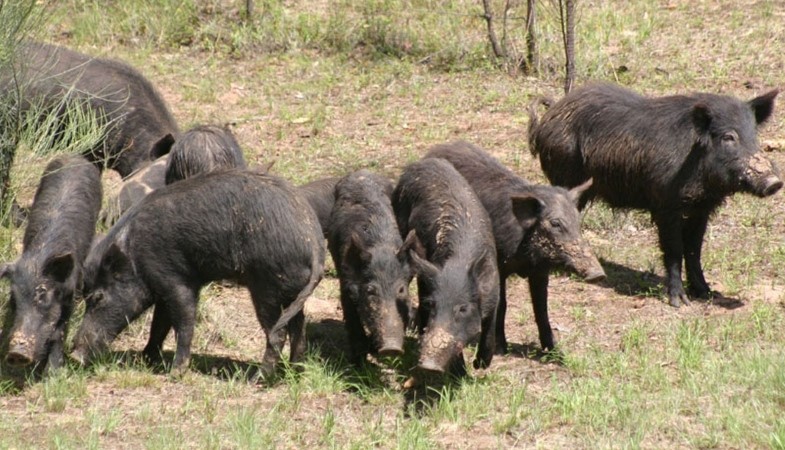
Feral pigs. Image: PIRSA
[22] David Choquenot, John McIlroy and Terry Korn: Managing Vertebrate Pests: Feral Pigs, Australian Government Publishing Service, Canberra, 1996
Introduction of weeds
Although there were olives on board the premier pioneer ship HMS Buffalo when it arrived in 1836, it was several decades before they became a well-established feral species in the Mount Lofty Ranges. Sir Samuel Davenport introduced the olive to Adelaide’s foothills in the 1870s when he planted 14,000 trees of 27 varieties at Beaumont. Some of those spread through pasture and bushland.
But some weeds or problem plants were already in South Australia. One analysis of historical records by Peter Kloot shows the extent of European plant introductions from 1802 to 1840 [23], as sealers, whalers, Aborigines, escapees and explorers on offshore islands and the mainland were all involved in clearing land on a small scale and introducing plant species with the potential to be weeds.
When Matthew Flinders’ ship Investigator visited Kangaroo Island in April 1802, orange, lemon, cherry, rockmelon, cantaloupe, cucumber, gourd, onion, leek, turnip, beet, radish, cress, mustard, lettuce, cabbage, savoy, spinach and sea kale seeds were sown close by the spring near Penneshaw. Kloot postulated that if the three fruit trees were seedlings, then it was likely there were weed propagules in the soil around the roots; the vegetable seeds were likely to have had impurities and thus weeds might have spread. Captain Sutherland planted cabbages there in 1819.
By 1831 there were a few small vegetable gardens of potatoes and onions and barley for the poultry. George Wallen, an unofficial settler who was thought to have lived on Kangaroo Island since about 1816, had 4 acres (1.6ha) of wheat in cultivation and a kitchen garden with a range of English vegetables [24]. Occasional visits by some of these islanders to the mainland may also have led to plant incursions there.
Althorpe Island in Investigator Strait and Thistle Island in Spencer Gulf were occupied by sealers, and from 1815 an escaped convict lived on Thistle Island with his two Aboriginal ‘wives’. His garden of wheat and barley together with his pigs, goats and poultry made them self-sufficient. Smaller groups of up to 30 people from 1829 to 1832 were also on the Eyre and Yorke Peninsulas and at Port Lincoln. All of these people may have relied on stock and crops from Tasmania or elsewhere, imports that were likely to have carried contaminants.
Official settlement from July 1836 saw more vegetables planted, first on Kangaroo Island and then on the mainland, with stock grazing on unfenced lands, colonists bringing agricultural, horticultural and ornamental or sentimental plants with them and a Government Garden was established in Adelaide in 1837 [25]. By the time competent botanists came to the colony from the mid 1840s it was impossible to differentiate between species introduced before or after 1836 [26]. Later species that became naturalised in South Australia included many from New South Wales, Victoria and New Zealand. Specimens were not collected systematically on Kangaroo Island until the 1880s. However, by 1850 about 100 alien plants had successfully established in South Australia [27].
Within five years of South Australia’s settlement, the following weeds had established: [28]
- Common in home gardens, vegetable growing areas and waste land: chick weed, couch grass, Canadian fleabane, French catchfly, dwarf mallow, nettle, nightshade, greater plantain, common verbena and winter grass.
- Commonly growing in field crops: hedge mustard, rye grass-perennial and wild oats.
- Common in grazing areas and on roadsides: barley grass, cape weed, dock, variegated thistle and common thorn-apple.
As seen by Ferdinand von Mueller’s ‘The Flora of South Australia’, weeds were a subject of public debate in the mid 19th century [29]. In its issue of 2 February 1849, the South Australian newspaper quoted from an article in the Hobart Town Advertiser that urged each man to destroy his own thistles. In fact, in November 1849 a Committee of the Legislative Council of Van Diemen’s Land (it was not called Tasmania until 1856) recommended the introduction of legislation to compel land owners to control thistles on their land. However, there is no record that any such legislation was enacted [30].
[23] P.M. Kloot, ‘Plant introductions to South Australia prior to 1840’ in Journal of Adelaide Botanic Gardens, 7(3): 217–31, 1985.
[24] Cumpston, 1974.
[25] Kloot, 1985, p. 223 citing State Records of SA, Colonial Secretary’s Office correspondence 1837/267a which records fruit trees bought for the garden, including ‘Oranges … dahlias, tiger lilies, rosetree, cherries, mulberry, quince, nectarine, Japanese loquats’. A letter of 9 August 1837 mentions the purchase of peach and apricot trees, mulberry, Lisbon lemon and flowers.
[26] Kloot, 1985, p. 222.
[27] P.M. Kloot, ‘Plant introductions to South Australia prior to 1840’ in Journal of Adelaide Botanic Gardens, 7(3): 217–31, 1985. Referring to Mueller 1853 and Kloot 1983.
[28] Tideman, A.F., ‘Ten Acts for Weed Control ,The history of weed control legislation in South Australia, 1850–1990, 2007, p. 6.
[29] Mueller, F., ‘The Flora of South Australia’ in Hooker’s Journal of Botany and Kew Gardens Miscellany, 5: 65–72, 1853.
[30] Hobart Colonial Times, Friday 17 November 1848 p 2
Scotch thistle
Scotch thistle
The obligation for all landowners to control thistles on their land became the major thrust of the first noxious weeds legislation in Australia: South Australia’s Scotch Thistle Act 1851. Although formally described as ‘An Act for preventing the further spread of Scotch Thistle’, it was not the real Scotch thistle that was being addressed, as this was not common in the new colony. Spear thistle was very widespread in the settled areas of South Australia having been introduced in 1841 and this weed was generally known as “Scotch thistle” [31].
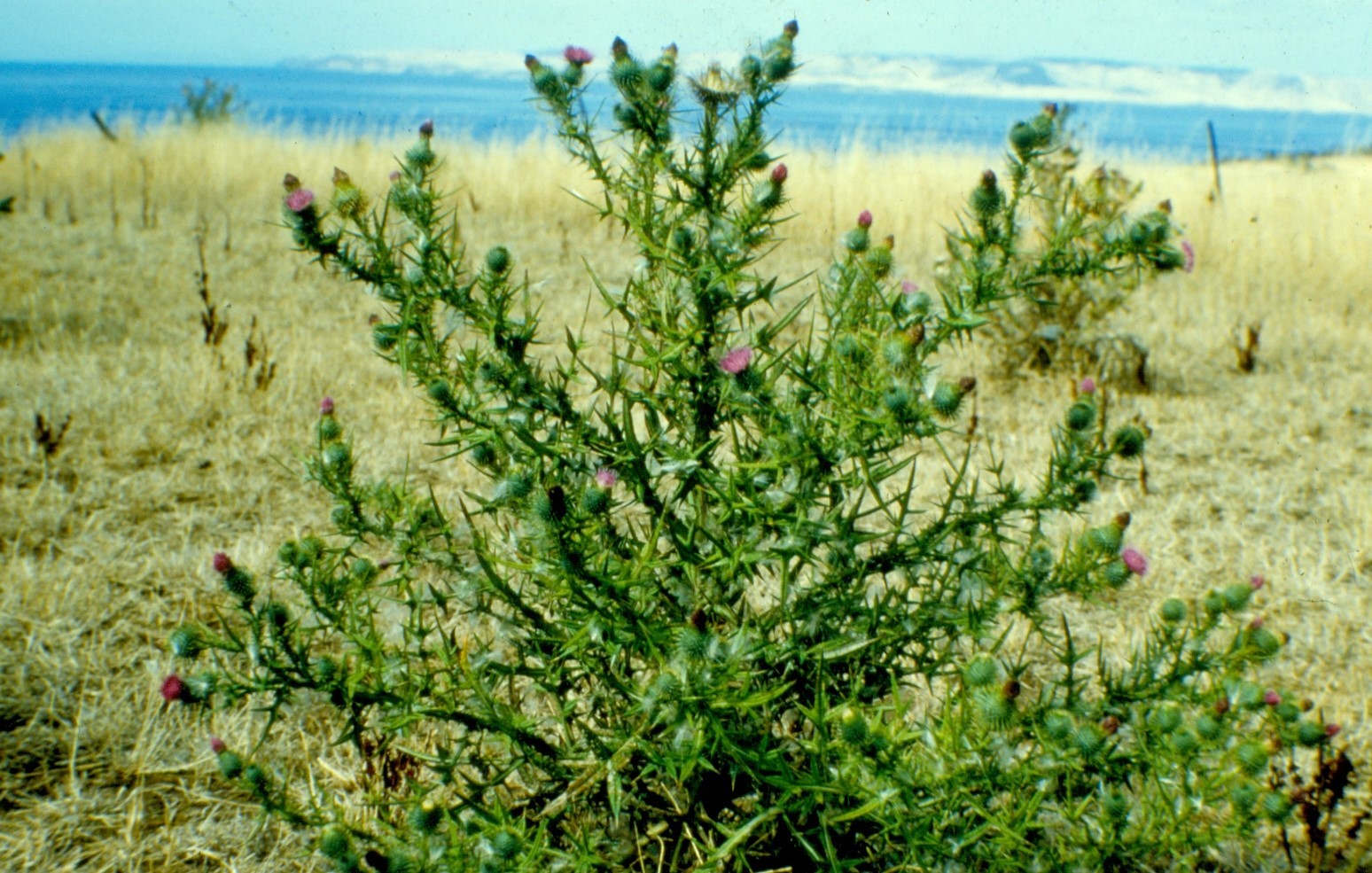
Spear thistle. Image: PIRSA
Indeed, various plants were known as Scotch thistle and the Act covered all purple-flowered thistles, including what is today known as variegated thistle. The owner or occupier of land was responsible for destroying the thistles on their land, including out to the centre of roads adjoining their land. Enforcement of the Act became a responsibility of a District Board of Roads, or a District Council, or by an order of any Justice of the Peace. An owner who did not act within seven days of receiving a notice to destroy thistles could be fined up to £10, which was several weeks’ wages for an unskilled labourer.
The Surveyor-General was made responsible for destroying thistles on Crown land. When the Bill was being debated, there were several people, including members of the Legislative Council, who doubted the effectiveness of the legislation. This was unquestionably the case as this and subsequent legislation had very little real impact on the spreading of thistles (progress was only made when the hormone herbicides in combination with the establishment of perennial pastures made control cost effective) [32]. However, the legislation did have its supporters.
[31] P.M. Kloot, ‘The naturalised flora of South Australia. 1. The documentation of its development’ in Journal of Adelaide Botanic Gardens, 10(1): 81–90, 1987, p. 88. Referring to Kloot 1983. At this time there were a few acres of it, reaching a height of eight or ten feet, at the back of Government House
[32] Tideman, p.10
Bathurst burr
Bathurst burr
A decade later the Thistle and Bur Act 1862, which replaced the Scotch Thistle Act, included Bathurst burr, which had probably been introduced by stock travelling from New South Wales and Queensland. While bur had been the spelling used in the legislation, burr became the conventional spelling.
In evidence to a Select Committee of the Legislative Council that considered the proposed new Act, the Surveyor-General said he thought the Scotch Thistle Act had been effective in preventing the spread of thistles, which were mainly confined to the agricultural districts. Bathurst burr may not have been observed until about 1850 so at the time of the first Thistle Act it would not have been a major weed in South Australia because it had not spread much and was confined to roadsides and stock reserves in agricultural areas. But it had now spread alarmingly in the interior. In badly affected parts of New South Wales it was now growing up to 12ft (3.7m) high [33].
Under this legislation, persons occupying land were responsible for the destruction of the thistles and Bathurst burr on the land they occupied, and on half of the road reserve adjacent to their land. The Act did not inflict a penalty for the non-destruction of these weeds until after a written notice has been served upon the owner/occupier and the requirements of the notice had not been carried out with the time limit imposed.

Bathurst burr. Image: Natural Resources SA
If the owner/occupier failed to comply with the notice then those who were authorised to issue the notices were further authorised to enter the land and arrange for the destruction of the weeds, the cost of destroying them being recoverable from the owner/occupier of the land, together with all costs of proceedings [34] (these principles have remained in all weed legislation and still apply today). However, this legislation also failed to suppress these weeds, this being recognised by 1872 when, recorded in Parliamentary proceedings, it was noted that the present law was lamentably defective, freely admitted by everyone acquainted with the subject, through laxity of administration and the absence of machinery and funds for carrying its provisions into effect [35].
A further attempt to improve the weed control legislation was introduced to Parliament in 1870 in the form of the Thistle Bill, designated to prevent the further spread of the Scotch thistle, variegated thistle and Bathurst bur and to add an additional weed – aster or stinkwort [36]. This Bill failed to pass Parliament. A Select Committee inquiry into a new Act in 1871 gathered some interesting information, although an updated Act was not passed at that time. The committee considered that the Thistle and Bur Act had failed to check the spread of Scotch thistle, despite the considerable sum that had been spent, and that this was partly because of legislative loopholes. They accused the government of wasting time with red tape while the thistles seeded, and claimed that too little money had been allocated to clear all the plants, which ‘left the remainder to seed the country’. Bathurst burr was still mainly confined to roads and reserves for travelling stock but Aster, or stinkwort, described as an annual, grew to the exclusion of grass after the crop had been taken off.
The failure of the successive Government’s attempts to control weeds was formally recognised in 1874 when the Chief Secretary (Sir Arthur Blyth) stated “that thistles had already spread to such an extent in many parts of the colony that the Government felt that it would be quite in vain now to insist upon their eradication. The provisions of the Act would, however, be enforced as regarded the Bathurst bur” [37].An anonymous letter to the editor of the South Australian Chronicle and Weekly Mail recognised that Scotch thistles were a stock food but it was almost unanimously agreed amongst farmers and stockowners that the detrimental effect these plants had on other vegetation and soil fertility immeasurably outweighed that benefit. However, the writer suggested a solution which was prophetic for that time. The writer proposed dividing the colony into districts, to be managed by local boards, with board members elected by those landowners who contribute to a fund to be raised for eradicating thistles, such a tax to be levied on all land of the colony, including the Crown's [38].
These boards would employ labourers, or let contracts, for eradicating thistles where-ever found growing. By such a plan, contributors to this fund would be directly interested in seeing this work was properly performed, the incentive being the sooner the thistle was eradicated the sooner would they be relieved from the 'tax’. It was to be another 10 years before the principle expressed by the writer was adopted, albeit in a limited form.
[33] SAPP 205: 1862.
[34] South Australian Weekly Chronicle (Adelaide, Saturday 22 November 1862: p 4)
[35] Evening Journal (Adelaide, Wednesday 2 October 1872 p 2)
[36] As laid on table and read first time, 9th September 1870. Notice of this appears p. 751 of South Australia Parliamentary Debates vol. 61.
[37] The Express and Telegraph (Adelaide, Friday 17 July 1874: p 2)
[38] South Australian Chronicle and Weekly Mail (Adelaide, SA: 1868–1881), Saturday 17 August 1872, page 4
Olives
Olives
Olives were first introduced to South Australia in 1836 and there were a number of further introductions to try and establish a viable industry. South Australia led the Australian olive industry importing thousands of trees that were planted in the Adelaide Park Lands and areas around Adelaide.
Some of these plantings were later abandoned causing the olives to naturalise, especially in wood land habitats. Feral olives soon displaced native vegetation and degraded fauna habitat. Feral olive trees generally produce smaller fruits than trees in cultivated orchards, both because the trees are unpruned and because they are no longer under selection for maximum fruit size. The pits of the smaller fruit are more easily dispersed by birds, facilitating their further spread [39].
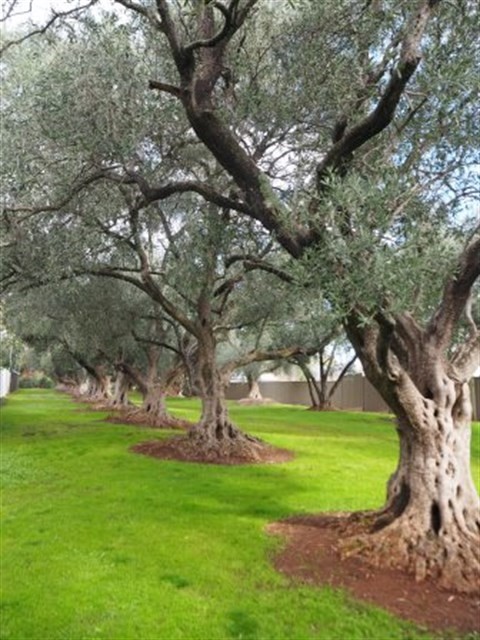
Davenport Olive Grove: Image: City of Burnside
The most serious weeds in South Australia in 1879 were Bathurst burr, cape weed, catchfly, Maltese cockspur, stinkwort, spear thistle and variegated thistle [40].
Promoting the introduction of exotic animals and plants
The early colonists were keen to import familiar animals from Europe and in 1840 the vessel Courier left England bound for Port Adelaide with a cargo that included farm animals and, in addition, three deer (a buck, and two does) and hares and rabbits to be let loose into the wild on arrival. That same year the vessel New Holland arrived with a number of pheasants and partridges, to commence the stocking of South Australia with game [41].
Support for such a ‘stocking program’ in the South Australian environment grew steadily over the next 20 years and this was facilitated by the lack of any import controls. By the early 1860s this movement became more organised and acclimatisation societies began to be formed. These societies were being established to encourage the introduction of non-native species in various places around the world with the hope of their acclimatisation and adaptation. The motivation at the time was a sense that introducing these species of plants and animals would enrich the flora and fauna of a region. These societies were born during a period of colonialism when Europeans began to settle in unfamiliar environments, and the movement sought to establish familiar plants and animals (mainly from Europe) in new areas while also bringing exotic and useful foreign plants and animals into the European centres (of course today it is widely understood that introducing species can be detrimental to native species and their ecosystems – at the time however, this was insufficiently understood). Introductions of commercially valuable species or game species were also made.
The appeal of acclimatisation societies in Australia was the belief that the local fauna was in some way deficient or impoverished; there was also an element of nostalgia in colonists who desired to see familiar species. It was here that the desire to make the land feel more like England was strongest. The Acclimatisation Society of Victoria was established in 1861 and societies were soon established in other States. The emergence of the field of ecology transformed expert and public opinion on introductions and gave way to new rules. Quarantine regulations began to be set up instead and thus began a halt to the movement [42].
A South Australian Acclimatisation Society appears to have been founded in 1864 but floundered after only a few months of activity. It was hoped that the Acclimatisation Society would encourage the introduction of new seed and plants as well as birds and animals. There was considered to be abundant scope in the colony, and the Society would find plenty of persons willing to assist in ascertaining the adaptability of new fruits and vegetables, and in recording the results [43]. In addition, the supporters of an Acclimatization Society considered its role was to provide for the suitable reception of birds and animals from overseas and to allow them to adapt to the new environment before releasing them [44].
In the 1860s, prominent individuals within the colony started to source animals, and in particular birds, from Europe for deliberate release into the South Australian environment. For example, in 1864 these individuals imported a badger and a bear to augment the collection at the Botanic Gardens and the following year English house sparrows were released in the hope they would destroy many of the worms and insects attacking the colony’s corn crop. It is recorded that the release of other fauna was planned but many animals did not survive the long sea voyage. Sparrows did survive and were established in the wild at Magill in 1868 and Mt Gambier in 1875 [45].
Many in the Colony supported ‘acclimatisation’, including those in Parliament. Legislation was passed in 1864 to protect imported or acclimatised animals and native birds. The Protection of Animals Act 1864 prevented the destruction of certain wild and acclimatised animals. The list of acclimatised animals included rabbits for which there was a closed season on the killing or destroying them from 1 August to 31 December, despite the problems they were causing. By 1874 this situation had changed as rabbit numbers increased and impact upon agriculture became more obvious. When pressure on the Government forced it to take action to legislate and compel owners of land, under a penalty, to destroy rabbits, it was realised that the Protection of Animals Act provided severe penalties to ensure rabbits were protected in the closed season. Accordingly, the Protection of Animals Act was repealed by the Game Act 1874, which continued most provisions of the repealed Act but deleted any protection for rabbits.
The South Australian Acclimatisation Society re-established on 23 July 1878 and many of the Colony’s leading business, political and legal figures were members. It was chiefly concerned with introducing and domesticating foreign fauna into the Colony, and especially birds from the British Isles in the hope that they would permanently establish to remind the settlers of the music and harmony of English country life (the Society has had several name changes and is now known as the Royal Zoological Society of South Australia but ‘Acclimatisation’ was not officially dropped until 1937) [46].
The Society began importing birds and a suitable aviary was erected in the Botanic Gardens for the Society's use. Skylarks, thrushes, goldfinches, bullfinches and blackbirds were released in 1879 and the Society received permission to liberate birds and fish in Government land and water reserves. Another eight species were being bred for release and it was their intention to “import and set loose English blackbirds, starlings and other insectivorous birds which have been ascertained to be beneficial and in no way injurious to gardens and farms” [47].
Whether the Society was able to adequately assess the pest potential of any animal or bird intended for release may now be seen as questionable, but this certainly was its aim. In fact the Chief Justice, Samuel Way, a founding member of the South Australian Acclimatisation Society, made it clear that although the Society was formed mainly to promote the introduction and acclimatisation of suitable birds and fish into the colony, if any were considered to be detrimental to any class of the community, they should not be imported [48].
But it should be noted that a further aim of these acclimatisation societies in Australia did include the preservation of native birds and animals. There was particular concern that many would become extinct and ‘become unknown to the grandchildren of the present colonists’ [49]. However, it is clear that the Society's members generally considered they were assisting to develop the colony but time has shown they had contributed problems to the local ecologies.
[41] South Australian Record and Australasian Chronicle (SA Saturday 28 March 1840 p 5)
[42] https://en.wikipedia.org/wiki/Acclimatisation_society, accessed 21 November 2018
[43] South Australian Register (Adelaide Tuesday 1 April 1862 p 2)
[44] South Australian Register (Adelaide Saturday 21 June 1862 p 5)
[45] SA Ornithologist, July 1, 1935 pp 92–98
[46] http://www.slsa.sa.gov.au/archivaldocs/srg/SRG263_RoyalZoologicalSociety_serieslist.pdf, accessed 21 November 2018
[47] SA Ornithologist, July 1, 1935 pp 92–98
[48] ibid
[49] South Australian Register (Adelaide Saturday 21 June 1862 p 5)
Sources of information
Sources of information
[1] Hodder 1893. Parkes, J., Henzell, R. & Pickles, G. Managing vertebrate pests: feral goats (AGPS, Canberra, 1996). Aitken in Corbett 1980. Evans 1980.
[2] http://www.environment.gov.au/biodiversity/invasive-species/publications/factsheet-european-red-fox-vulpes-vulpes, accessed 19/11/19.
[3] N. Newland, ‘Vermin control in South Australia: An historical account of legislative efforts to control animals defined as ‘vermin’’.
[4] The Manning Index of South Australian History: Rabbits, SLSA.
[5] Peacock, D and Abbott, I: The role of quoll (Dasyurus) predation in the outcome of pre-1900 introductions of rabbits (Oryctolagus cuniculus) to the mainland and islands of Australia, Australian Journal of Zoology, 2013, 61, 206–280.
[6] N. Newland, citing Papers relative to South Australia. Presented to both Houses of Parliament (London, HMSO, 1843), provides the year of 1840.
[7] Adelaide Observer (SA Saturday 30 September 1843 p 4) and South Australian Register (Adelaide Wednesday 13 December 1843 p 2)
[8] ‘The Manning Index of South Australian History’: South Australia – Flora and Fauna: Rabbits’
[9] Adelaide Observer (SA: 1843–1904), Saturday 5 August 1871, page 9
[10] South Australian Register (Adelaide, SA: 1839 –1900), Saturday 13 August 1870, page 8
[11] Manning
[12] Hodder, p. 276.
[13] Manning
[14] Newland citing SAPP137:1879.
[15] Newland – p. 2
[16] South Australian Register (Adelaide, SA: 1839–1900), Wednesday 28 August 1878, page 3
[17] South Australian Register (Adelaide, SA: 1839–1900), Saturday 10 February 1877, page 6
[18] South Australian Gazette and Colonial Register (Adelaide, SA: 1836–1839) Sat 16 Sep 1837, Page 1
[19] Newland – p.4.
[20] Daly, The Adelaide hunt, pp. 7–8.
[21] South Australian Register (Adelaide, SA: 1839–1900), Saturday 21 June 1845, page 3 and South Australian Register (Adelaide, SA: 1839–1900), Monday 31 May 1869, page 3.
[22] David Choquenot, John McIlroy and Terry Korn: Managing Vertebrate Pests: Feral Pigs, Australian Government Publishing Service, Canberra, 1996
[23] P.M. Kloot, ‘Plant introductions to South Australia prior to 1840’ in Journal of Adelaide Botanic Gardens, 7(3): 217–31, 1985.
[24] Cumpston, 1974.
[25] Kloot, 1985, p. 223 citing State Records of SA, Colonial Secretary’s Office correspondence 1837/267a which records fruit trees bought for the garden, including ‘Oranges … dahlias, tiger lilies, rosetree, cherries, mulberry, quince, nectarine, Japanese loquats’. A letter of 9 August 1837 mentions the purchase of peach and apricot trees, mulberry, Lisbon lemon and flowers.
[26] Kloot, 1985, p. 222.
[27] P.M. Kloot, ‘Plant introductions to South Australia prior to 1840’ in Journal of Adelaide Botanic Gardens, 7(3): 217–31, 1985. Referring to Mueller 1853 and Kloot 1983.
[28] Tideman, A.F., ‘Ten Acts for Weed Control ,The history of weed control legislation in South Australia, 1850–1990, 2007, p. 6.
[29] Mueller, F., ‘The Flora of South Australia’ in Hooker’s Journal of Botany and Kew Gardens Miscellany, 5: 65–72, 1853.
[30] Hobart Colonial Times, Friday 17 November 1848 p 2
[31] P.M. Kloot, ‘The naturalised flora of South Australia. 1. The documentation of its development’ in Journal of Adelaide Botanic Gardens, 10(1): 81–90, 1987, p. 88. Referring to Kloot 1983. At this time there were a few acres of it, reaching a height of eight or ten feet, at the back of Government House
[32] Tideman, p.10
[33] SAPP 205: 1862.
[34] South Australian Weekly Chronicle (Adelaide, Saturday 22 November 1862: p 4)
[35] Evening Journal (Adelaide, Wednesday 2 October 1872 p 2)
[36] As laid on table and read first time, 9th September 1870. Notice of this appears p. 751 of South Australia Parliamentary Debates vol. 61.
[37] The Express and Telegraph (Adelaide, Friday 17 July 1874: p 2)
[38] South Australian Chronicle and Weekly Mail (Adelaide, SA: 1868–1881), Saturday 17 August 1872, page 4
[39] Declared Plant Policy for Olive (Olea europaea), PIRSA
[40] Tideman, p. 6.
[41] South Australian Record and Australasian Chronicle (SA Saturday 28 March 1840 p 5)
[42] https://en.wikipedia.org/wiki/Acclimatisation_society, accessed 21 November 2018
[43] South Australian Register (Adelaide Tuesday 1 April 1862 p 2)
[44] South Australian Register (Adelaide Saturday 21 June 1862 p 5)
[45] SA Ornithologist, July 1, 1935 pp 92–98
[46] http://www.slsa.sa.gov.au/archivaldocs/srg/SRG263_RoyalZoologicalSociety_serieslist.pdf, accessed 21 November 2018
[47] SA Ornithologist, July 1, 1935 pp 92–98
[48] ibid
[49] South Australian Register (Adelaide Saturday 21 June 1862 p 5)
Author: Kevin Gogler based on an original text by Bernie O’Neil.
Prepared November 2018 and updated September 2020
